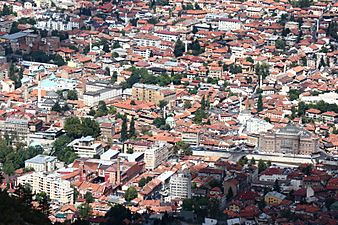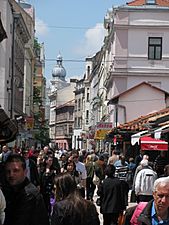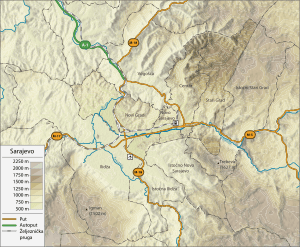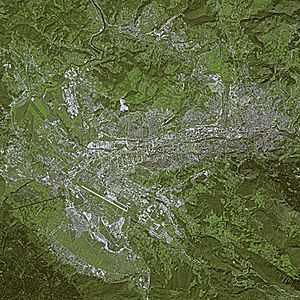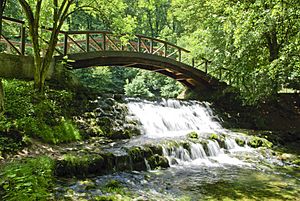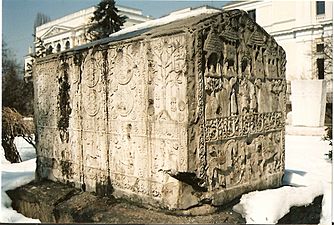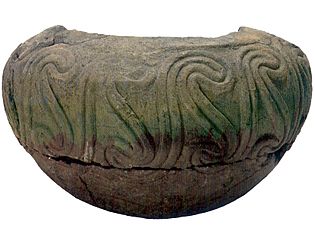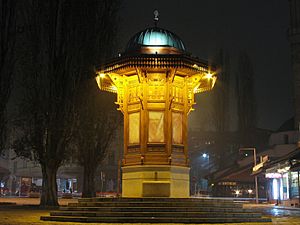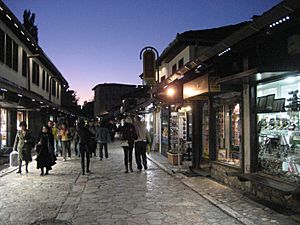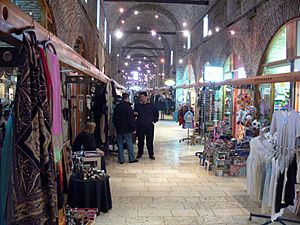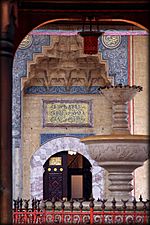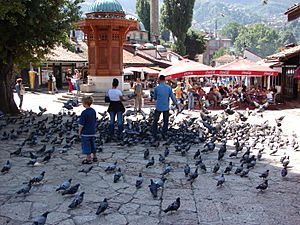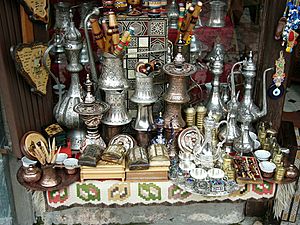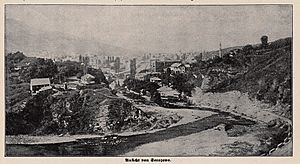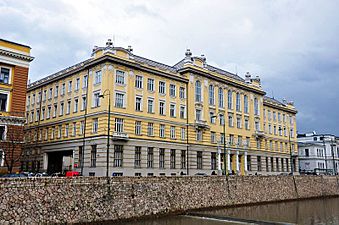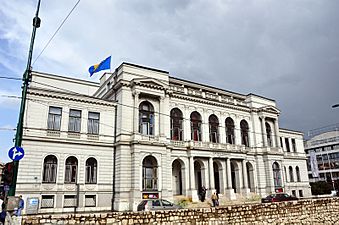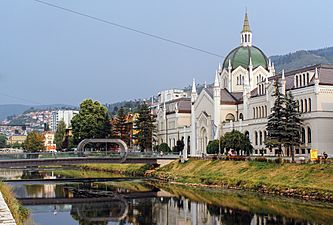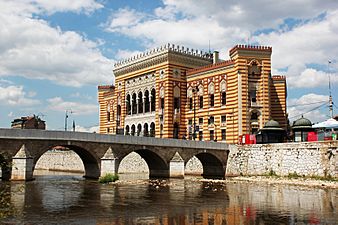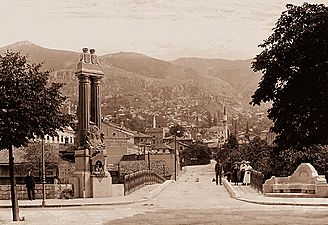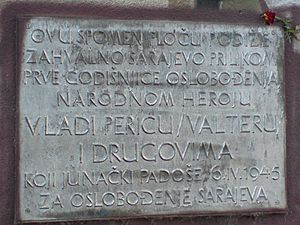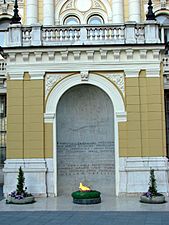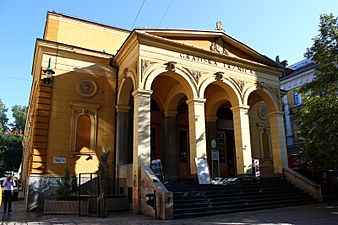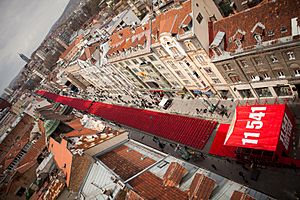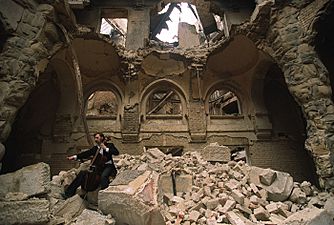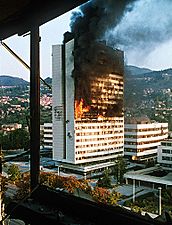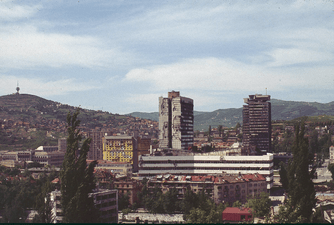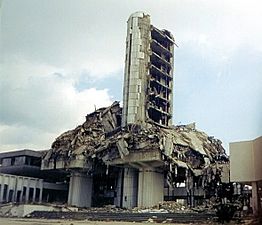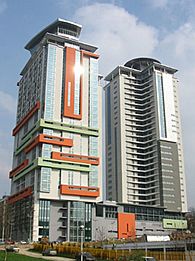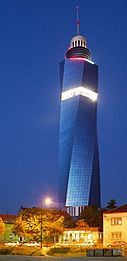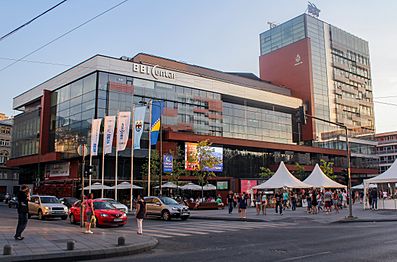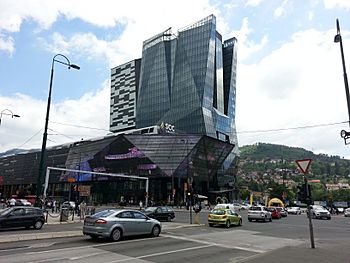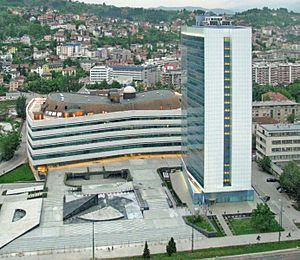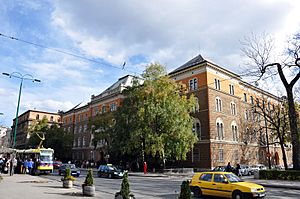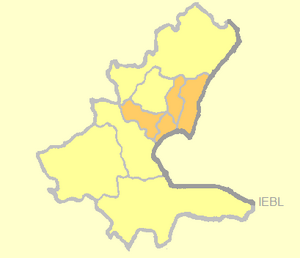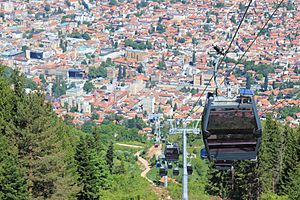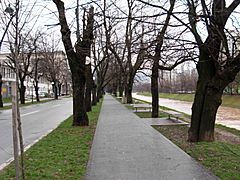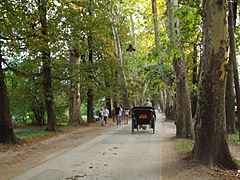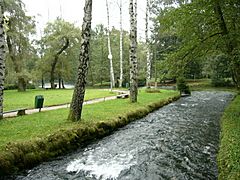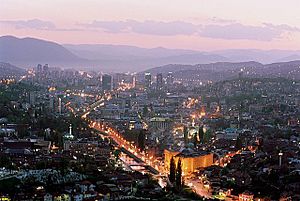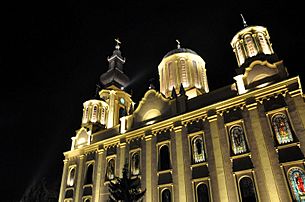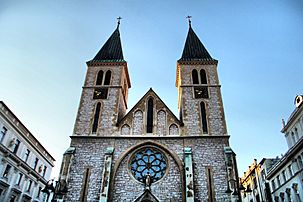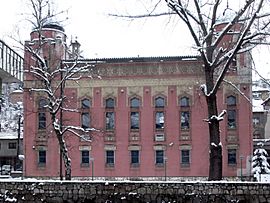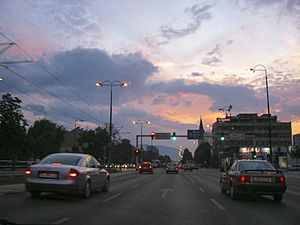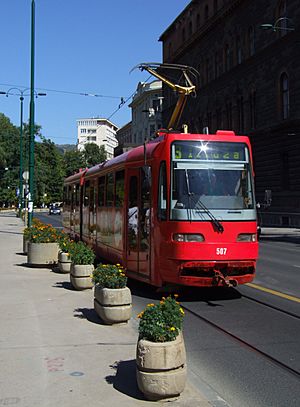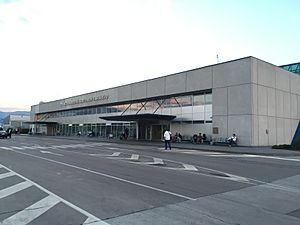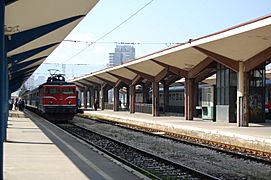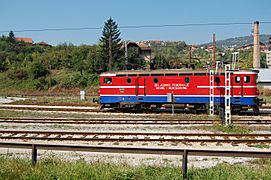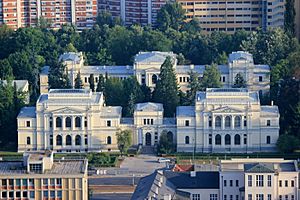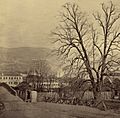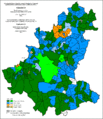Sarajevo facts for kids
Quick facts for kids
Sarajevo
Сарајево
|
|||
|---|---|---|---|
   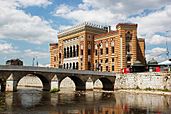  
From top, left to right: Sarajevo panorama, Emperor's Mosque, Sarajevo Cathedral, Orthodox Cathedral, Sarajevo Library, Latin Bridge, and Sebilj.
|
|||
|
|||
| Nickname(s):
Jerusalem of Europe, Jerusalem of the Balkans, Rajvosa
|
|||
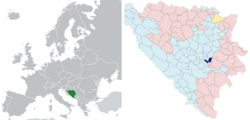
Location in Europe and Bosnia and Herzegovina (dark blue)
|
|||
| Country | Bosnia and Herzegovina | ||
| Entity | Federation of Bosnia and Herzegovina | ||
| Canton | Sarajevo Canton | ||
| Municipalities | 4 | ||
| Area | |||
| • Urban | 141.5 km2 (54.3 sq mi) | ||
| Elevation | 518 m (1,699 ft) | ||
| Population
(Census 2013.)
|
|||
| • Urban | 395,133 | ||
| • Metro | 688,437 | ||
| • City proper | 275,524 | ||
| • Demonym | Sarajevan | ||
| Time zone | UTC+1 (CET) | ||
| • Summer (DST) | UTC+2 (CEST) | ||
| Postal code |
71000
|
||
| Area code(s) | +387 (33) | ||
| Website | City of Sarajevo | ||
Sarajevo is the capital city of Bosnia and Herzegovina. It has an estimated population of 436.000 people in the urban area including some municipalities from City of East Sarajevo which is the part of Republika Srpska entity. The city has people living in it from a large number of different cultures. It has mosques, synagogues, and churches. The 1984 Winter Olympics were held in Sarajavo.
During the Siege of Sarajevo, parts of the city were destroyed. Most of the city is now recovered and rebuilt.
Contents
Environment
Geography
Sarajevo is near the geometric center of the triangular-shaped Bosnia-Herzegovina and within the historical region of Bosnia proper. It is situated 518 meters (1,699 ft) above sea level and lies in the Sarajevo valley, in the middle of the Dinaric Alps. The valley itself once formed a vast expanse of greenery, but gave way to urban expansion and development in the post-World War II era. The city is surrounded by heavily forested hills and five major mountains. The highest of the surrounding peaks is Treskavica at 2,088 meters (6,850 ft), then Bjelašnica mountain at 2,067 meters (6,781 ft), Jahorina at 1,913 meters (6,276 ft), Trebević at 1,627 meters (5,338 ft), with 1,502 meters (4,928 ft) Igman being the shortest. The last four are also known as the Olympic Mountains of Sarajevo (see also 1984 Winter Olympics). The city itself has its fair share of hilly terrain, as evidenced by the many steeply inclined streets and residences seemingly perched on the hillsides.
The Miljacka river is one of the city's chief geographic features. It flows through the city from east through the center of Sarajevo to west part of city where eventually meets up with the Bosna river. Miljacka river is "The Sarajevo River", with its source (Vrelo Miljacke) 2 kilometres (1.2 miles) south of the town of Pale at the foothills of Mount Jahorina, several kilometers to the east of Sarajevo center. The Bosna's source, Vrelo Bosne near Ilidža (west Sarajevo), is another notable natural landmark and a popular destination for Sarajevans and other tourists. Several smaller rivers and streams such as Koševski Potok also run through the city and its vicinity.
Cityscape
Sarajevo is close to the center of the triangular shape of Bosnia and Herzegovina in southeastern Europe. Sarajevo city proper consists of four municipalities (or "in Bosnian and Croatian: općina, in Serbian: opština"): Centar (Center), Novi Grad (New City), Novo Sarajevo (New Sarajevo), and Stari Grad (Old City), while Metropolitan area of Sarajevo (Greater Sarajevo area) includes these and the neighbouring municipalities of Ilidža, Hadžići, Vogošća and Ilijaš.
The Metropolitan area was reduced in the 1990s after the war and the Dayton-imposed administrative division of the country, with several municipalities partitioned along the border of the newly recognised Federation of Bosnia and Herzegovina (FBiH) and Republica Srpska (RS), creating several new municipalities which together form the city of Istočno Sarajevo in the Republica Srpska: Istočna Ilidza, Istočno Novo Sarajevo, Istočni Stari Grad, Lukavica, Pale (RS-section), and Trnovo (RS-section), along with the municipality of Sokolac (which was not traditionally part of the Sarajevo area and was not partitioned)
The city has an urban area of 1,041.5 square kilometres (402.1 sq mi). Veliki Park (Great park) is the largest green area in the center of Sarajevo. It's nestled between Titova, Koševo, Džidžikovac, Tina Ujevića and Trampina Streets and in the lower part there is a monument dedicated to the Children of Sarajevo.
Climate
Sarajevo has either a humid continental climate (Köppen climate classification: Dfb), or an oceanic climate (Köppen climate classification: Cfb), depending on if either the 0°C or the -3°C isotherms are used. Sarajevo's climate exhibits four seasons and uniformly spread precipitation, typical of both Cfb and Dfb climates. The proximity of the Adriatic Sea moderates Sarajevo's climate somewhat, although the mountains to the south of the city greatly reduce this maritime influence. The average yearly temperature is 10 °C (50 °F), with January (−0.5 °C (31.1 °F) on average) being the coldest month of the year and July (19.7 °C (67.5 °F) on average) the warmest.
The highest recorded temperature was 40.7 °C (105 °F) on 19 August 1946, and on 23 August 2008 (41.0) while the lowest recorded temperature was −26.2 °C (−15.2 °F) on 25 January 1942. On average, Sarajevo has 7 days where the temperature exceeds 32 °C (89.6 °F) and 4 days where the temperature drops below −15 °C (5 °F) per year. The city typically experiences mildly cloudy skies, with an average yearly cloud cover of 45%.
The cloudiest month is December (75% average cloud cover) while the clearest is August (37%). Moderate precipitation occurs fairly consistently throughout the year, with an average 75 days of rainfall. Suitable climatic conditions have allowed winter sports to flourish in the region, as exemplified by the Winter Olympics in 1984 that were celebrated in Sarajevo. Average winds are 28–48 km/h (17–30 mph) and the city has 1,769 hours of sunshine.
History
![]() Ottoman Empire 1461–1878
Ottoman Empire 1461–1878
![]() Austro-Hungarian Empire 1878–1918
Austro-Hungarian Empire 1878–1918
![]() State of Slovenes, Croats and Serbs 1918
State of Slovenes, Croats and Serbs 1918
![]() Kingdom of Serbs, Croats and Slovenes 1918–1929
Kingdom of Serbs, Croats and Slovenes 1918–1929
![]() Kingdom of Yugoslavia 1929–1941
Kingdom of Yugoslavia 1929–1941
![]() Independent State of Croatia 1941–1945
Independent State of Croatia 1941–1945
![]() SFR Yugoslavia 1945–1992
SFR Yugoslavia 1945–1992
![]() Republic of Bosnia and Herzegovina 1992–1997
Republic of Bosnia and Herzegovina 1992–1997
![]() Bosnia and Herzegovina 1997–Present
Bosnia and Herzegovina 1997–Present
Ancient times
One of the earliest findings of settlement in the Sarajevo area is that of the Neolithic Butmir culture. The discoveries at Butmir were made on the grounds of the modern-day Sarajevo suburb Ilidža in 1893 by Austro-Hungarian authorities during the construction of an agricultural school. The area's richness in flint was attractive to Neolithic humans, and the settlement flourished. The settlement developed unique ceramics and pottery designs, which characterize the Butmir people as a unique culture, as described at the International Congress of Archaeologists and Anthropologists meeting in Sarajevo in 1894.
The next prominent culture in Sarajevo were the Illyrians. The ancient people, who considered most of the West Balkans as their homeland, had several key settlements in the region, mostly around the river Miljacka and the Sarajevo valley. The Illyrians in the Sarajevo region belonged to the Daesitiates, the last Illyrian people in Bosnia and Herzegovina to resist Roman occupation. Their defeat by the Roman emperor Tiberius in 9 AD marks the start of Roman rule in the region. The Romans never built up the region of modern-day Bosnia, but the Roman colony of Aquae Sulphurae was near the top of present-day Ilidža, and was the most important settlement of the time. After the Romans, the Goths settled the area, followed by the Slavs in the 7th century.
Middle Ages
During the Middle Ages Sarajevo was part of the Bosnian province of Vrhbosna near the traditional center of the Kingdom of Bosnia. Though a city named Vrhbosna existed, the exact settlement in Sarajevo at this time is debated. Various documents note a place called Tornik in the region, most likely in the area of Marijin Dvor neighborhood. By all indications, Tornik was a very small marketplace surrounded by a proportionally small village, and was not considered very important by Ragusan merchants.
Other scholars say that Vrhbosna was a major town in the wider area of modern-day Sarajevo. Papal documents say that in 1238, a cathedral dedicated to Saint Paul was built in the area. Disciples of the notable saints Cyril and Methodius stopped in the region, founding a church near Vrelo Bosna. Whether or not the town was somewhere in the area of modern-day Sarajevo, the documents attest to its and the region's importance. There was also a citadel Hodidjed north-east to Old City, dating from around 1263 until it was occupied by the Ottoman Empire in 1429.
Ottoman era
Sarajevo was founded by the Ottoman Empire in the 1450s upon its conquest of the region, with 1461 used as the city's founding date. The first Ottoman governor of Bosnia, Isa-Beg Ishaković, transformed the cluster of villages into a city and state capital by building a number of key structures, including a mosque, a closed marketplace, a public bath, a hostel, and of course the governor's castle ("Saray") which gave the city its present name. The mosque was named "Careva Džamija" (the Tsar's Mosque) in honor of the Sultan Mehmed II. With the improvements Sarajevo quickly grew into the largest city in the region. By the 15th Century the settlement was established as a city, named Bosna-Saraj, around the citadel in 1461. The name Sarajevo is derived from Turkish saray ovası, meaning the field around saray.
Following the expulsion of Jews from Spain at the end of the 15th century, and the invitation from the Ottoman Empire to resettle their population, Sephardic Jews arrived in Sarajevo, which over time would become a leading center of Sephardic culture and the Ladino language. Though relatively small in size, a Jewish quarter would develop over several blocks in Baščaršija.
Many local Christians converted to Islam at this time. To accommodate the new pilgrims on the road to Mecca, in 1541 Gazi Husrev-Bey’s quartermaster Vekil-Harrach built a Pilgrim's mosque for which it is still known to this day Hadžijska mosque.
Under leaders such as the second governor Gazi Husrev-beg, Sarajevo grew at a rapid rate. Husrev-beg greatly shaped the physical city, as most of what is now the Old Town was built during his reign. Sarajevo became known for its large marketplace and numerous mosques, which by the middle of the 16th century numbered more than 100. At the peak of the empire, Sarajevo was the biggest and most important Ottoman city in the Balkans after Istanbul. By 1660, the population of Sarajevo was estimated to be over 80,000. By contrast, Belgrade in 1683 had 100.000, and Zagreb as late as 1851 had 14,000 people. As political conditions changed, Sarajevo became the site of warfare.
In 1697, during the Great Turkish War, a raid was led by Prince Eugene of Savoy of the Habsburg Monarchy against the Ottoman Empire, which conquered Sarajevo and left it plague-infected and burned to the ground. After his men had looted thoroughly, they set the city on fire and destroyed nearly all of it in one day. Only a handful of neighborhoods, some mosques, and an Orthodox church, were left standing. Numerous other fires weakened the city, which was later rebuilt but never fully recovered from the destruction. By 1807, it had only some 60,000 residents.
In the 1830s, several battles of the Bosnian uprising had taken place around the city. These had been led by Husein Gradaščević. Today, a major city street is named Zmaj od Bosne (Dragon of Bosnia) in his honor. The rebellion failed and for several more decades the Ottoman state remained in control of Bosnia.
The Ottoman Empire made Sarajevo an important administrative centre by 1850. Baščaršija became the central commercial district and cultural center of the city in the 15th century when Isa-Beg Isaković founded the town. The toponym Baščaršija derives from the Turkish language.
Austria-Hungary
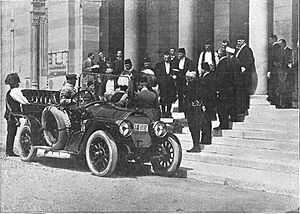
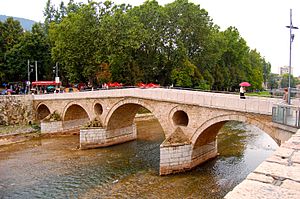
Austria-Hungary's occupation of Bosnia and Herzegovina came in 1878 as part of the Treaty of Berlin, and complete annexation followed in 1908, angering the Serbs. Sarajevo was industrialized by Austria-Hungary, who used the city as a testing area for new inventions such as tramways, which were established in 1885 before they were later installed in Vienna. Architects and engineers wanting to help rebuild Sarajevo as a modern European capital rushed to the city. A fire that burned down a large part of the central city area (čaršija) left more room for redevelopment. As a result, the city has a unique blend of the remaining Ottoman city market and contemporary western architecture. Sarajevo also has some examples of Secession- and Pseudo-Moorish styles that date from this period.
The Austro-Hungarian period was one of great development for the city, as the Western power brought its new acquisition up to the standards of the Victorian age. Various factories and other buildings were built at this time, and a large number of institutions were both Westernized and modernized. For the first time in history, Sarajevo's population began writing in Latin script. For the first time in centuries, the city significantly expanded outside its traditional borders. Much of the city's contemporary central municipality (Centar) was constructed during this period.
Architecture in Sarajevo quickly developed into a wide range of styles and buildings. The Cathedral of Sacred Heart, for example, was constructed using elements of neo-gothic and Romanesque architecture. The National Museum, Sarajevo brewery, and City Hall were also constructed during this period. Additionally, Austrian officials made Sarajevo the first city in this part of Europe to have a tramway.
Although the Bosnia Vilayet de jure remained part of the Ottoman Empire, it was de facto governed as an integral part of Austria-Hungary with the Ottomans having no say in its day-to-day governance. This lasted until 1908 when the territory was formally annexed and turned into a condominium, jointly controlled by both Austrian Cisleithania and Hungarian Transleithania.
In the event that triggered World War I, Archduke Franz Ferdinand of Austria was assassinated, along with his wife Sophie, Duchess of Hohenberg in Sarajevo on 28 June 1914 by Gavrilo Princip, an ethnic Serb and self-declared Yugoslav, and member of Young Bosnia. This was followed by the Anti-Serb riots in Sarajevo, which resulted in two deaths and destruction of property.
In the ensuing war, however, most of the Balkan offensives occurred near Belgrade, and Sarajevo largely escaped damage and destruction. Following the war, Bosnia was annexed into the Kingdom of Yugoslavia, and Sarajevo became the capital of the Drina Province.
- Architecture from Austro-Hungarian period
Yugoslavia
After World War I and pressure from the Serbian army, alongside rebelling Slavic nations in Austria-Hungary, Sarajevo became part of the Kingdom of Yugoslavia. Though it held some political significance as the center of first the Bosnian region and then the Drinska Banovina, the city was no longer a national capital and saw a decline in global influence.
During World War II the Kingdom of Yugoslavia's army was overrun by German and Italian forces. Following a German bombing campaign, Sarajevo was captured on 15 April 1941 by the 16th Motorized infantry Division. The Axis powers created the Independent State of Croatia and included Sarajevo in its territory.
Immediately following the occupation, the main Sephardi Jewish synagogue, Il Kal Grande, was looted, burned, and destroyed by the Nazis. Within a matter of months, the centuries-old Sephardi and Ashkenazi Jewish communities of Sarajevo, comprising the vast majority of Bosnian Jewry, would be rounded up in the Old Synagogue (Stari hram) and deported to their deaths in Croatian concentration camps. Roughly 85% of Bosnia's Jewish population would perish at the hands of the Nazis and the Ustaše during the Holocaust. The Sarajevo Haggadah was the most important artifact which survived this period, smuggled out of Sarajevo and saved from the Nazis and Ustaše by the chief librarian of the National Museum, Derviš Korkut.
On 12 October 1941, a group of 108 notable Bosniak citizens of Sarajevo signed the Resolution of Sarajevo Muslims by which they condemned the persecution of Serbs organized by the Ustaše, made a distinction between the Bosniaks who participated in such persecutions and the rest of the Bosniak population, presented information about the persecutions of Bosniaks by Serbs, and requested security for all citizens of the country, regardless of their identity. By mid-summer 1942, around 20,000 Serbs found refuge in Sarajevo from Ustaše terror.
The city was bombed by the Allies from 1943 to 1944. The Yugoslav Partisan movement was represented in the city. In period February–May 1945 Maks Luburić set up Ustaše headquarters in a building known as Villa Luburić and used it as torture and execution place whose 323 victims were identified after the war. Resistance was led by Vladimir "Walter" Perić, who died while leading the liberation of the city on 6 April 1945.
After the war, Sarajevo was the capital of the Socialist Republic of Bosnia and Herzegovina within the Socialist Federal Republic of Yugoslavia. The Republic Government invested heavily in Sarajevo, building many new residential blocks in Novi Grad Municipality and Novo Sarajevo Municipality, while simultaneously developing the city's industry and transforming Sarajevo into a modern city. Sarajevo grew rapidly as it became an important regional industrial center in Yugoslavia. Between the end of the war and the end of Yugoslavia, the city grew from a population of 115,000 to more than 600,000 people. The Vraca Memorial Park, a monument for victims of World War II, was dedicated on 25 November, the "Day of Statehood of Bosnia and Herzegovina" when the ZAVNOBIH held their first meeting in 1943.
A crowning moment of Sarajevo's time in Socialist Yugoslavia was the 1984 Winter Olympics. Sarajevo beat out Sapporo, Japan; and Falun/Göteborg, Sweden to host the Olympic games. The games were followed by a tourism boom, making the 1980s one of the city's most prosperous decades.
- Iconic buildings of Sarajevo, Socialist Republic of Bosnia and Herzegovina
Siege of Sarajevo during Bosnian War
The Bosnian War for independence resulted in large-scale destruction and dramatic population shifts during the Siege of Sarajevo between 1992 and 1996. Thousands of Sarajevans lost their lives under the constant bombardment and sniper shooting at civilians by the Serb forces during the siege, the longest siege of a capital city in the history of modern warfare. Bosnian Serb forces of the Republika Srpska and the Yugoslav People's Army besieged Sarajevo from 5 April 1992 to 29 February 1996.
When Bosnia and Herzegovina declared independence from Yugoslavia and achieved United Nations recognition, Serbian leaders declared a new Serbian national state Republika Srpska (RS) which was carved out from the territory of Bosnia and Herzegovina. The Serbian Army encircled Sarajevo with a siege force of 18,000 stationed in the surrounding hills, from which they assaulted the city with artillery, mortars, tanks, anti-aircraft guns, heavy machine-guns, multiple rocket launchers, rocket-launched aircraft bombs, and sniper rifles. From 2 May 1992, the Serbs blockaded the city. The Bosnian government defence forces inside the besieged city were poorly equipped and unable to break the siege.
During the siege, 11,541 people lost their lives. An additional 56,000 people were wounded. The 1991 census indicates that before the siege the city and its surrounding areas had a population of 525,980.
When the siege ended, the concrete scars caused by mortar shell explosions left marks that were filled with red resin. After the red resin was placed, it left floral patterns which led to them being dubbed Sarajevo Roses.
- Sarajevo structural damage and destruction
-
Vedran Smailović playing a cello on top of the ruins of the National library (in 1992)
Present
Various modern buildings now occupy Sarajevo's skyline, most significantly the Bosmal City Center, BBI Centar, Sarajevo City Center and the Avaz Twist Tower, which at the time of its building was the tallest skyscraper in former Yugoslavia.
Recent years have seen population growth as well as increases in tourism. In 2014 the city saw anti-government protests and riots and record rainfall that caused historic flooding.
- Images of modern Sarajevo
Administration
Largest city of Bosnia and Herzegovina
Sarajevo is the capital of the country of Bosnia and Herzegovina and its sub-entity, the Federation of Bosnia and Herzegovina, as well as of the Sarajevo Canton. It is also the de jure capital of another entity, Republika Srpska. Each of these levels of government has its parliament or council, as well as judicial courts, in the city. All national institutions and foreign embassies are in Sarajevo.
Sarajevo is home to the Council of Ministers of Bosnia and Herzegovina, Parliamentary Assembly of Bosnia and Herzegovina, Presidency of Bosnia and Herzegovina, the Constitutional Court of Bosnia and Herzegovina and the operational command of the Armed Forces of Bosnia and Herzegovina.
Bosnia and Herzegovina's Parliament office in Sarajevo was damaged heavily in the Bosnian War. Due to damage the staff and documents were moved to a nearby ground level office to resume the work. In late 2006, reconstruction work started on the Parliament and was finished in 2007. The cost of reconstruction is supported 80% by the Greek Government through the Hellenic Program of Balkans Reconstruction (ESOAV) and 20% by Bosnia-Herzegovina.
Municipalities and city government
The city comprises four municipalities Centar, Novi Grad, Novo Sarajevo, and Stari Grad. Each operate their own municipal government, united they form one city government with its own constitution. The executive branch (Bosnian: Gradska Uprava) consists of a mayor, with two deputies and a cabinet. The legislative branch consists of the City Council, or Gradsko Vijeće. The council has 28 members, including a council speaker, two deputies, and a secretary. Councilors are elected by the municipality in numbers roughly proportional to their population. The city government also has a judicial branch based on the post-transitional judicial system as outlined by the High Representative's "High Judicial and Prosecutorial Councils".
Sarajevo's Municipalities are further split into "local communities" (Bosnian, Mjesne zajednice). Local communities have a small role in city government and are intended as a way for ordinary citizens to get involved in city government. They are based on key neighborhoods in the city.
Economy
Sarajevo's large manufacturing, administrative, and tourism sectors make it the strongest economic region of Bosnia and Herzegovina.
While Sarajevo had a large industrial base during its communist period, only a few pre-existing businesses have successfully adapted to the market economy. Sarajevo industries now include tobacco products, furniture, hosiery, automobiles, and communication equipment. Companies based in Sarajevo include BH Telecom, Bosnalijek, Energopetrol, Sarajevo Tobacco Factory, and Sarajevska Pivara (Sarajevo Brewery).
Tourism and recreation
Sarajevo has a wide tourist industry and a fast expanding service sector thanks to the strong annual growth in tourist arrivals. Sarajevo also benefits from being both a summer and winter destination with continuity in its tourism throughout the year. The travel guide series, Lonely Planet named Sarajevo as the 43rd best city in the world, and in December 2009 listed Sarajevo as one of the top ten cities to visit in 2010.
In 2019 573.227 tourists visited Sarajevo, giving 1.060.988 overnight stays, which is 18,8% more than in 2017.
Sports-related tourism uses the legacy facilities of the 1984 Winter Olympics, especially the skiing facilities on the nearby mountains of Bjelašnica, Igman, Jahorina, Trebević, and Treskavica. Sarajevo's 600 years of history, influenced by both Western and Eastern empires, makes it a tourist attraction with splendid variations. Sarajevo has hosted travellers for centuries, because it was an important trading center during the Ottoman and Austria-Hungarian empires and because was a natural stop for many routes between East and West. Examples of popular destinations in Sarajevo include the Vrelo Bosne park, the Sarajevo cathedral, and the Gazi Husrev-beg's Mosque. Tourism in Sarajevo is chiefly focused on historical, religious, cultural sites and winter sports.
Sarajevo is host to many parks throughout the city and on the outskirts of city. A popular activity among Sarajevo citizens is street chess, usually played at Trg oslobođenja Alija Izetbegović. Veliki Park is the largest green area in the center of Sarajevo. It's nestled between Titova, Koševo, Džidžikovac, Tina Ujevića and Trampina Streets and in the lower part there is a monument dedicated to the Children of Sarajevo. Hastahana is a popular place to relax in the Austro-Hungarian neighborhood of Marijin Dvor. Goat's Bridge, locally known as Kozija Ćuprija, in the Miljacka Canyon is also a popular park destination along the Dariva walkway and river Miljacka. On December 24 of 2012, a park hosting two brass sculptures resembling two mourning mothers was dedicated as the Friendship Park, commemorating over 45 years of friendship between Sarajevo and [Baku].
Sarajevo is also famous for its city lookouts; including an observation deck on Avaz Twist Tower, Park Prinčeva restaurant, Vidikovac lookout (Mt. Trebević), Zmajevac lookout and Yellow/White fortresses lookouts (in Vratnik) as well as numerous other rooftops throughout the city (i.e. Alta Shopping Center, BBI Center, Hotel Hecco Deluxe). A symbol of Sarajevo is the Trebevic cable car which was reconctructed in 2018, also it is one of the most popular tourist attractions in the city taking visitors from the city center to mount Trebevic.
- Parks, rivers and public spaces in Sarajevo
Demographics
| Ethnic composition of Sarajevo city proper, by municipalities, 2013 census | ||||||
| Municipality | Total | Bosniaks | Serbs | Croats | Others | |
| Centar | 55,181 | 41,702 (75.57%) | 2,186 (3.96%) | 3,333 (6.04%) | 7,960 (14.42%) | |
| Novi Grad | 118,553 | 99,773 (84.16%) | 4,367 (3.68%) | 4,947 (4.17%) | 9,466 (7.98%) | |
| Novo Sarajevo | 64,814 | 48,188 (74.35%) | 3,402 (5.25%) | 4,639 (7.16%) | 8,585 (13.24%) | |
| Stari Grad | 36,976 | 32,794 (88.69%) | 467 (1.3%) | 685 (1.85%) | 3,030 (8.19%) | |
| Total | 275,524 | 222,457 (80.74%) | 10,422 (3.78%) | 13,604 (4.94%) | 29,041 (10.54%) | |
- Heralded as the 'European Jerusalem' due to city's diverse ethnic and religious makeup
Transportation
Roads and highways
Sarajevo's location in a valley between mountains makes it a compact city. Narrow city streets and a lack of parking areas restrict automobile traffic but allow better pedestrian and cyclist mobility. The two main roads are Titova Ulica (Street of Marshal Tito) and the east-west Zmaj od Bosne (Dragon of Bosnia) highway (E761). Located roughly at the center of the country, Sarajevo is Bosnia's main intersection. The city is connected to all the other major cities by highway or national road like Zenica, Banja Luka, Tuzla, Mostar, Goražde and Foča.
Tourists from Central Europe and elsewhere visiting Dalmatia driving via Budapest through Sarajevo also contribute to the traffic congestion in and around Sarajevo. The trans-European highway, Corridor 5C, runs through Sarajevo connecting it to Budapest in the north, and Ploče at the Adriatic sea in the south. The highway is built by the government and should cost 3.5 billion Euro. Up until March 2012, the Federation of Bosnia and Herzegovina invested around 600 million Euro in the A1. In 2014 the sections Sarajevo-Zenica and Sarajevo-Tarcin were completed including the Sarajevo Beltway ring road.
Tram, bus and trolleybus
Sarajevo's electric tramways, in operation since 1885, are the oldest form of public transportation in the city. Sarajevo had the first full-time (dawn to dusk) tram line in Europe, and the second in the world.
There are seven tramway lines supplemented by five trolleybus lines and numerous bus routes. The main railroad station in Sarajevo is in the north-central area of the city. From there, the tracks head west before branching off in different directions, including to industrial zones in the city. Sarajevo is undergoing a major infrastructure renewal; many highways and streets are being repaved, the tram system is undergoing modernization, and new bridges and roads are under construction.
Cable car (Mt. Trebević)
Trebević Cable Car, Sarajevo's key landmark during 1984 Winter Olympic Games, was rebuilt by JKP GRAS Sarajevo and Sarajevo Canton as one of the new transportation systems in 2017 and it reopened on 6 April 2018 at 11:00 AM. The cable car runs from Sarajevo at Bistrik station to the slopes of Trebević at Vidikovac station.
Airport
Sarajevo International Airport (IATA: SJJ), also called Butmir, is just a few kilometers southwest of the city and was voted Best European Airport With Under 1,000,000 Passengers at the 15th Annual ACI-Europe in Munich in 2005.
Railway
Sarajevo has daily international connections which twice a day connect the city with Zagreb and Ploče. There are also connections between Sarajevo and all major cities within Bosnia and Herzegovina. Once, the East Bosnian railway connected Sarajevo to Belgrade. The Sarajevo railway station is among the biggest in Europe.
- Sarajevo Railway
International relations
Twin towns – Sister cities
Sarajevo is twinned with:
|
|
Fraternity cities
Sarajevo's fraternity cities include:
|
|
|
Education
Higher Education
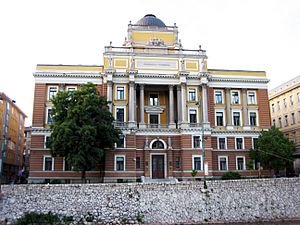
Higher education has a long and rich tradition in Sarajevo. The first institution that can be classified as a tertiary educational institution was a school of Sufi philosophy established by Gazi Husrev-beg in 1537; numerous other religious schools have been established over time. In 1887, under the Austro-Hungarian Empire, a Sharia Law School began a five-year program. In the 1940s the University of Sarajevo became the city's first secular higher education institute, effectively building upon the foundations established by the Saraybosna Hanıka in 1537. In the 1950s, post-bachelor graduate degrees became available. Severely damaged during the war, it was recently rebuilt in partnership with more than 40 other universities.
There are also several universities in Sarajevo, including:
- University of Sarajevo
- Sarajevo School of Science and Technology
- International University of Sarajevo
- American University in Bosnia and Herzegovina
- Sarajevo Graduate School of Business
- International Burch University
Primary and Secondary Education
As of 2005[update], in Sarajevo there are 46 elementary schools (Grades 1–9) and 33 high schools (Grades 10–13), including three schools for children with special needs,
There are also several international schools in Sarajevo, catering to the expatriate community; some of which are Sarajevo International School and the French International School of Sarajevo, established in 1998.
Culture
Sarajevo has been home to many different religions for centuries, giving the city a range of diverse cultures. In the time of Ottoman occupation of Bosnia, Muslims, Serbian Orthodox, Roman Catholics, and Sephardi Jews all shared the city while maintaining distinctive identities. They were joined during the brief occupation by Austria-Hungary by a smaller number of Germans, Hungarians, Slovaks, Czechs and Ashkenazi Jews. By 1909, about 50% of the city's inhabitants were Muslim, 25% were Catholic, 15% were Orthodox, and 10% were Jewish.
Historically, Sarajevo has been home to several prominent Bosnian poets, scholars, philosophers and writers. To list only a very few; Nobel Prize-winner Vladimir Prelog is from the city, as are the writer Zlatko Topčić and the poet Abdulah Sidran. Nobel Prize-winner Ivo Andrić attended high school in Sarajevo for two years. Academy Award-winning director Danis Tanović live in the city.
The Sarajevo National Theatre is the oldest professional theater in Bosnia and Herzegovina, having been established in 1921.
Images for kids
-
A panoramic view of Sarajevo valley from "Yellow Bastion" (Žuta tabija) lookout, spring 2012.
-
The signing of the Dayton Agreement in Paris ended the 3 1⁄2-year-long Bosnian War.
-
Bijelo Dugme originated in Sarajevo; widely considered to have been the most popular band ever to exist in the former Yugoslavia and one of the most important acts of the Yugoslav rock scene. Pictured are Mladen Vojičić Tifa (left) and Goran Bregović (right).
-
Bosnian football player Edin Džeko was born in Sarajevo. He is the all-time leading goalscorer of the Bosnia and Herzegovina national football team.
-
Koševo City Stadium, home to FK Sarajevo, is the largest stadium in Bosnia and Herzegovina.
-
Damir Džumhur, a Sarajevo born multi–Grand Slam tennis player.
-
Gazi Husrev-beg Library - Baščaršija Islamic School (Kurumlija Madrasa).
-
Iconic Sarajevo Holiday Inn (now Hotel Holiday) and UNITIC World Trade Towers.
-
Medieval tombstones around the National Museum of Bosnia and Herzegovina.
See also
 In Spanish: Sarajevo para niños
In Spanish: Sarajevo para niños




